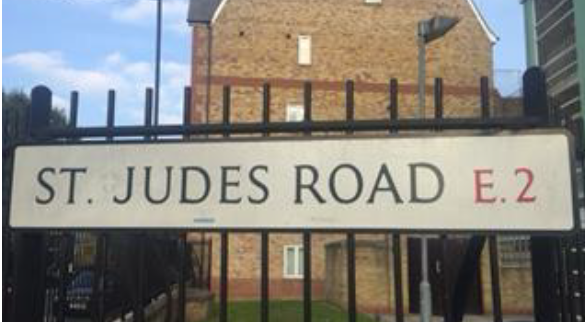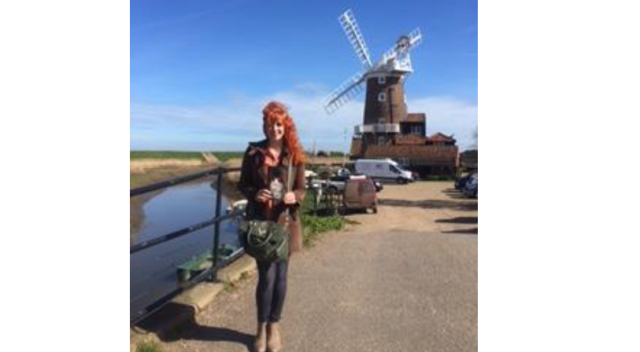Welcome to my exclusive Crimson & Bone blog, which will take you round London, Norfolk, Florence and Venice, visiting the places which inspired my novel.

I’m starting in the same place as the book. This is Waterloo Bridge, where my heroine, low-‐born prostitute Annie Stride, attempts to leap to her death at the novel’s opening, and where her friend, the unfortunate Mary-‐Jane, met her watery death. This bridge has a very grisly history — there were so many suicides from this spot -‐ often ‘ruined’ women — that it became known as the Bridge of Sighs. The artist George Frederic Watts painted a picture of such an unfortunate woman, and called his piece Found Drowned. His work forms the basis for my fictional artist Francis Maybrick Gill’s painting of a drowned Mary Jane under Waterloo Bridge, entitled The Bridge of Sighs.

Here we are in Gower Street, where I imagined Francis’s house to be. It’s in a smart part of the Borough of Westminster very near the British Museum. The blue plaque at number seven denotes the house where the Pre-‐Raphaelite brotherhood was formed, and since I identify Francis with the movement this seemed like the street for him. The houses give on to the picturesque Bedford Square. When Francis saves Annie at Waterloo Bridge and takes her to Gower Street, his house would have presented a marked contrast to her home in Bethnal Green.

For the interior of Gower Street I visited one of the best-‐preserved residences of an affluent Victorian artist. At Frederic Leighton’s House (now a museum) in Kensington you can see a perfectly preserved interior, with gorgeous jewel-‐coloured wallpaper, a winter studio with vast windows, and even a beautiful little fountain court tiled in teal and gold which recalls the Moorish bathhouses of the Alhambra. Leighton painted the iconic Flaming June and, as an artist who fell in love with his low-‐born model Ada Pullan, formed part of the inspiration for her character of Francis Maybrick Gill.

This is St Jude’s Road in Bethnal Green. Today it has some pleasant housing by the railway line, but in Victorian times it would have been little better than a slum.

The Old George is a very old public house dating from well before Annie’s time, and still stands today. It’s a lovely gastro pub now, but in the story it represents the darkest moments of Annie’s life, for it was in the upper room of the Old George that she endured the horrific abuse of her childhood.

This is the church of St Matthew in Bethnal Green, not very far from the old George pub. This is where Annie made her only contact with religion, attending Sunday school and learning to read. It was from the priest of St Matthew’s that she learned the Bible stories she would later remember in Florence, particularly the story of Mary Magdalene, the saint whom she embodies for Francis.

One of the greatest pleasures of writing this book was embracing the incredible Victorian art that is all around me in my home city of London. The tube at Pimlico hints at the wonders that await you in the nearby Tate Britain.

It was at the Tate Britain that I enjoyed one of the most enchanting moments of my research for this book. My daughter had a very early interview at a nearby school which meant I got to the Tate just as it was opening. For thirty minutes I got to be the only person in a vast room full of priceless pre-‐Raphaelites. It’s an experience I highly recommend, to have all those beautiful, serene faces staring down at you from the walls, and all those swags and hanks of red and gold hair hanging down around you.

For the darker side of the story I had great Gothic fun exploring the Wellcome Collection and the Hunterian Museum at the Royal College of Surgeons. The Hunterian does a very nice line in horrible things in belljars, and the Wellcome medical collection has some fascinating exhibits which in Victorian times might have been labelled ‘Freakish’. That such exhibits share a city with those beautiful pre-Raphaelite women perfectly illustrates what is fascinating to me about Victorian society, the beautiful, civilised face and the dark underbelly; the skull beneath the skin. This contrast is the central theme of Crimson & Bone.

Here I am in Norfolk, where the story began for two of my characters, Mary Jane and Francis. Both grew up on this beautiful coast, in very different circumstances. Mary Jane was the daughter of two felons — her father was sent to the ‘Hulks’ or prison ships, and her mother ‘hanged by mistake’, sadly a common consequence of the law

At the other end of the social scale, Francis Maybrick Gill was brought up in the
beautiful Holkham Hall, pictured here. He would have been a privileged child, indulged
by a fond mother, and alienated by a strict and distant father. Young Francis’s life changed when his father entered into an affair with a prostitute, and it was on this lake that Francis’s life changed forever. The events at Holkham affected Francis profoundly, and at Holkham’s ornamental lake his obsession with women and water began.

The second half of the novel takes place in Italy. Francis and Annie’s Italian odyssey begins in Florence, at the Ponte Vecchio.
 This incredible bridge is not just part of the infrastructure of Florence, but part of her artistic heritage too. The arcades on the bridge house goldsmith’s shops below, and above the colonnades lies a secret corridor connecting the Uffizi gallery with the Medici palazzo in the Boboli gardens. The corridor is filled with priceless art, and the art of the Uffizi is hugely significant to the story. In the Uffizi’s hallowed halls Francis teaches Annie about the art that is important to him — the visceral, bloody art which came before Raphael. And there too she meets two characters who are to become very important to her — one long dead and one very much alive. For it is here that she sees Mary Magdalene for the first time since Sunday School, and here too she first feels the
This incredible bridge is not just part of the infrastructure of Florence, but part of her artistic heritage too. The arcades on the bridge house goldsmith’s shops below, and above the colonnades lies a secret corridor connecting the Uffizi gallery with the Medici palazzo in the Boboli gardens. The corridor is filled with priceless art, and the art of the Uffizi is hugely significant to the story. In the Uffizi’s hallowed halls Francis teaches Annie about the art that is important to him — the visceral, bloody art which came before Raphael. And there too she meets two characters who are to become very important to her — one long dead and one very much alive. For it is here that she sees Mary Magdalene for the first time since Sunday School, and here too she first feels the
gaze of the mysterious Rainbow Man.

And so to Venice where our story ends. Francis and Annie visit the Fenice theatre for the
world premiere of La Traviata. The story of the opera, the tale of a fallen prostitute who is elevated to mistress, echoes Annie’s own. Strangely, the opera was not well-‐received on its opening night, but it became a firm favourite over the centuries that followed, and, as you can see from this playbill, is still playing at the Fenice to this day.

The Fenice is a jewel of a theatre, painted in eggshell-‐turquoise and gold. It’s like being inside a jewel box. Performances here have to be particularly eye catching as it’s easy just to sit and gaze at the decor. Even Napoleon and Josephine, who attended a performance here, were said to have been impressed by such riches.

We end where we began — at a bridge. This is the actual Bridge of Sighs, the bridge from which Waterloo Bridge got it’s nickname. This bridge was so called because it connected the Doge’s palace to the notorious ‘Piombi’ the prisons of Venice. The prisons were reputed to be inescapable because the guards were told that if their charges escaped they themselves would finish the felon’s sentence. Only one man ever managed it — a certain Giacomo Casanova. Because they knew they would never escape, condemned prisoners always crossed the bridge with a sigh, as they looked their last on the world. In Crimson & Bone the bridge represents an ending too — but for whom, and how, I can’t say. You’ll just have to read the book, and I hope you do!
Thanks and love,
Marina xx

Museum photographs courtesy of visitlondon.com
CRIMSON & BONE by Marina Fiorato is out now from Hodder & Stoughton
Follow Marina on twitter @marinafiorato
Instagram @marinafiorato
Website marinafiorato.com
